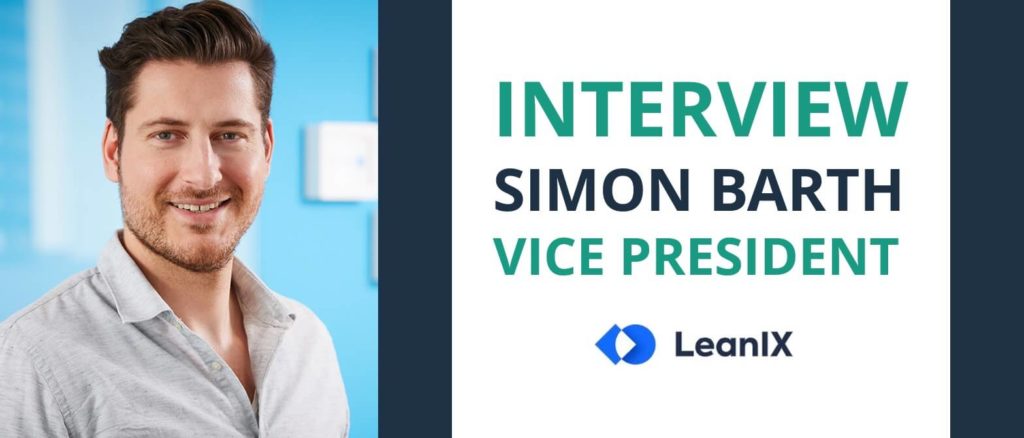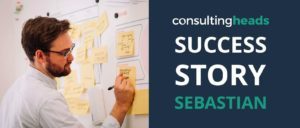Simon ist ehemaliger Unternehmensberater, aber eigentlich brennt er schon immer für das Thema „Startups“. Nachdem er nach seinem Consulting-Exit selbst eine Fitness-App entwickelt hatte, arbeitet er heute als Vice President bei unserem Unternehmenspartner LeanIX, einem sehr erfolgreichen und schnell wachsenden Tech-Startup. In einem Interview teilt Simon seinen Karriereweg und lässt Dich dabei auch an seinen Rückschlägen teilhaben. Er erzählt von seinem Erfolg bei LeanIX, was das Unternehmen so besonders macht und warum er consultingheads weiterempfiehlt. Viel Spaß beim Lesen!
About Simon and his career
Would you like to introduce yourself to our users? How has your career been so far?
In 2015, I started working at LeanIX, a Bonn-based software-as-a-service provider for the management of complex IT portfolios. Large companies often have thousands of technologies in use. We help them to maintain an overview – this is important for making good IT management decisions. Over the past few years at LeanIX, I have worked in a variety of roles. For me, the central question in each of these roles was: How can we scale faster?
Startups have been on my mind a lot since I was a student and never really let go afterwards. I founded my first company while still at university and worked in management consulting for several years before returning to the startup industry.
Fitness App, Setbacks & Lessons
After your studies, you joined DHL Consulting as a management consultant. Then you’ve decided to exit into startup founding – not easy, because about 80% of all startups fail in Germany. Do you also have an instructive Failure-Story ready for us?
After several years with DHL Consulting the topic of “startups” came up strongly in me again. I just felt like building something new.
I’ve always loved to exercise – but after long days at work, I often found it hard to motivate myself to go to the gym. I tried out various apps, but none of them really convinced me. To me, it lacked the aspect of committing in any way.
So I developed an app myself that used GPS to track visits to the gym. The beauty of the concept was that you could put money on your own fitness goals to motivate yourself to work out.
We were able to generate users for our app pretty quickly, but we also had to deal with massive problems. GPS tracking has proven to be technically difficult. Due to the money involved, we had to deal with numerous hurdles towards gambling and our monetization model required very high user numbers. In addition, we had financed everything completely out of our own pockets and were slowly running out of steam. After a few hard months, we finally decided to stop the project.
In the future, I would definitely do things differently:
- I would only work with a well-coordinated and complementary team of founders,
- choose a subject in which I have several years of experience
- and rely on a business model that generates significant revenues from the outset.
The year was very exhausting and stressful for me, but it also brought me a lot of personal progress. All in all, I wouldn’t advise anyone not to start a business – if only to learn a lot in a short time and to cure themselves of the “I should have” syndrome. On the other hand, I think that one should not romanticize the reasons too much, as it often happens in American literature. You should question exactly what your motives are for founding a company and whether you are really well suited for it. Joining a startup at an early stage can be a super alternative. In very small companies, there is plenty of room for each employee to act entrepreneurially, without the very big pressure.
Joining LeanIX and connection to consultingheads
Four years ago you joined LeanIX a B2B software provider in the field of Enterprise Architecture (EA), which is also a corporate partner ofconsultingheads is. You also recommended consultingheads to an acquaintance, for whom we then successfully found a new challenge. How did it come about?
I already know the two LeanIX founders André Christ and Jörg Beyer from my time at DHL Consulting. I worked with both of them on my very first consulting project, a global IT study. We had to laboriously gather information about the IT landscape of a business unit through workshops in Bonn, Singapore, and Atlanta, with a lot of travel. This experience alone made it clear to me that there must be a great need for a modern enterprise architecture solution. The existing customers were already very well-known companies at the time. This, in addition to the good cooperation in the past, convinced me to start at LeanIX.
In a fast-growing company, recruiting is always an issue. At the same time, we have seen that a consulting background is very helpful in many roles, for example in the strategic support of companies (customer success management). This brought consultingheads to our attention and we are always posting jobs. In this context, I noticed a challenging leadership role in a company in the digital economy in the consultingheads newsletter that was a good fit for a former colleague and friend.
Simon’s typical workday as vice president at LeanIX
What does your job at LeanIX look like, what exactly are your responsibilities and how does a normal working day as Vice President work for you?
Together with my team, I am responsible for scaling our sales processes globally. In short, we make sure that salespeople can successfully focus on selling and that our customers have a first-class experience in the process. It is an exciting and challenging task, as we are growing very fast as a company and have to integrate many new colleagues in sales quickly.
Since my working day is very dynamic in itself, routines play an important role for me. I always take a few minutes in the morning to sort out my thoughts in a journal. I plan the most important tasks for the day and hold a standup meeting with the team. When I’m not on the road, I therefore always work in our Bonn office. Here I have super equipment and am quickly in a productive mindset.
The rest of the day I spend on project work, coordination meetings, interviews with applicants and many ad-hoc challenges. During a normal working day, a whole zoo of tools has become indispensable for me: Todoist, Slack, Salesforce, Hubspot, Jira, Confluence, Box and Zoom are in daily use.
Why LeanIX? Strong team and positive corporate culture
In 2018, LeanIX was not only ranked the 10th fastest-growing technology company in Germany, but since the beginning of the year it has also been considered the best employer in information and communication technology. Your careers page will quickly show why. What makes LeanIX better than other employers?
LeanIX scores very well on rating platforms such as kununu & co. Hygiene factors such as a cool office, high-quality work equipment, and attractive compensation certainly also play a role. But much more important are a strong team and a positive corporate culture.
In some cases, we are currently hiring more new colleagues each month than there were in the company as a whole just a few years ago.
Every new employee changes the culture a bit, which is great if you get the right people on board. That’s why it’s impossible to overstate the impact of recruiting on corporate culture.
Simon Barth, Vice President at LeanIX
At the same time, however, we want to retain elements of our corporate culture that have made us successful. Three aspects that I personally value highly in the LeanIX culture are: Speed, Transparency and Results. These elements are reflected in many aspects of the way we work. That’s important, because I’m convinced that corporate culture has to become visible and can’t be imposed via a few posters on the wall.
For example, we work according to the “OKR” management method (Objectives and Key Results), which is designed to make corporate goals transparent and measurable. For me, the approach helps me understand how my work pays into the overall goals of the company. In the implementation we enjoy a lot of freedom as far as the organization of the work is concerned.
Another long-standing part of our culture is a bi-weekly, company-wide meeting where the various teams present their work. This keeps everyone in the company informed about progress in various areas. Our CEO André Christ, provides a regular update on where we stand as a company – including financially. So everyone in the company gets deep insights, even into sensitive topics. I think this trust helps so that everyone in the company takes responsibility.
About new customer acquisition and celebrating the successes
LeanIX has now built up an impressive portfolio of big-name customers such as Adidas, Merck, DHL and Zalando. Do you have a special ritual when acquiring a new client? And which customer did you particularly celebrate here?
We welcome every new LeanIX customer with a bell ringing . All employees gather and get a brief overview of our newest client and success factors that led to the deal.
For a real tech startup, of course, a little tech gamification is part of the game. Attached to the bell is a ‘dash button’ that sends a Slack message to the entire company informing them that there’s something to celebrate in a few minutes.
Of course, we are happy about every customer, but it makes me proud when DAX companies like Adidas, Deutsche Telekom, or Volkswagen use our product. But I’m at least as happy to see that we can also add value for fast-growing tech companies, such as Atlassian or Zalando. These are all companies that were themselves startups not so long ago, but are now extremely successful on the market and thus serve as role models for us.
Thanks for the interesting interview and the detailed insights, Simon! We are looking forward to seeing what happens next at LeanIX and wish you continued success!






